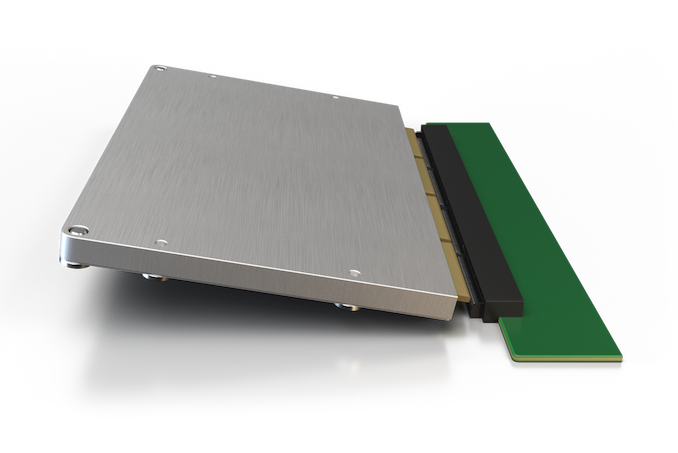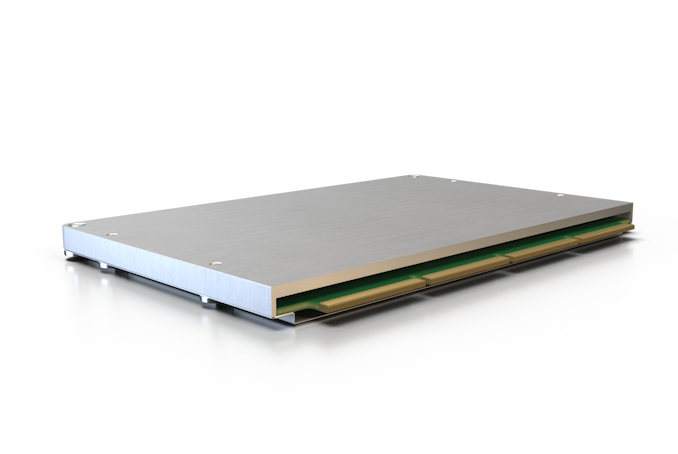Intel Launches the NUC Compute Element for Modular Computing Systems
by Ganesh T S on June 3, 2019 9:00 AM EST- Posted in
- Intel
- Systems
- Trade Shows
- NUC
- Computex 2019
- Compute Element

Intel's NUC lineup of ultra-compact and small form-factor systems has been a bright spot in the desktop PC market for the better part of this decade. Starting with the original 10cm x 10cm board, Intel has continuously been trying to push different form-factors to better target allied markets in this space. We have had slightly larger boards catering to the enthusiast market under the NUC tag (such as the Skull Canyon and Hades Canyon NUCs). More compact form-factors were experimented with in the Compute Stick family, but, that didn't last beyond a couple of years. More recently, the credit card-sized Compute Card modular computing initiative was discontinued after just one generation. However, Intel seems to have taken the feedback from the Compute Card's market deployment and developed a new product family to expand the reach of modular computing systems.
The Compute Card put the processor and RAM in a fully-enclosed credit-card sized module. It was compact and had a simple connector to enable interfacing with a dock that had the actual I/O. Though the cards and the docks eventually made its way into the retail market, the actual target audience was OEMs and other high-volume manufacturers of computing systems who could actually benefit from the modularization. For that market, the Compute Card only fulfilled a few requirements - simplification of the system-level design and the ability to create very compact systems. The cost, feature set (in terms of I/O capabilities), and performance (due to the thermal limitations inherent in a compact credit-card sized casing) were not up to the mark.
Intel's NUC Compute Element addresses these three issues (cost, performance, and increased I/O capabilities), while retaining the ability to simplify system design. Unlike the enclosed nature of the Compute Card, the NUC Compute Element is more like a Wi-Fi module with a heat spreader on top. Inclusive of the connector sticking out of the card, the NUC Compute Element comes in at 95mm x 65mm x 6mm (compared to the Compute Card's 95mm x 55mm x 5mm). It can accommodate up to U-series Core processors (typically, 15W) and provide a large performance range compared to the erstwhile Compute Card models (which topped out at 6W). The NUC Compute Element has also been optimized for battery usage for laptops, and the larger set of connector pins enable more I/O options for the final system.
One of the key driving factors in the creation of the Compute Card was the end-user accessibility for the card - enabling users to take a Card out of one device and move it to another, or take one out and replace it three years later with a newer version. However, Intel seems to have over-estimated the importance of this ability for the targeted user-base. Intel claims that the removal of the easy user accessibility in the NUC Compute Element has enabled system-design simplification and decreased the eventual system cost by around $50 - $70. Intel confirmed that a lot of the engineering effort that went into the Compute Card has come in handy for the NUC Compute Element.
We also checked with Intel about the extra I/O offered by the NUC Compute Element - while the Compute Card came with USB-C and a proprietary extension connector, the new product has a connector that simply brings out the I/O pins from the CPU. This enables device manufacturers to use the signals as they desire. The exact I/O specifications were not divulged.
It is safe to say that the NUC Compute Element, with its lower system cost compared to the Compute Card-equipped designs, will prove to be more popular among OEMs and other high-volume computing system manufacturers. In their press release, Intel indicated that education market-targeting notebooks built upon the NUC Compute Element will become available in early 2020.
| Want to keep up to date with all of our Computex 2019 Coverage? | ||||||
 Laptops |
 Hardware |
 Chips |
||||
| Follow AnandTech's breaking news here! | ||||||
Source: Intel











16 Comments
View All Comments
1_rick - Monday, June 3, 2019 - link
"Inclusive of the connector sticking out of the card""Including the connector..." is a better phrasing.
ballsystemlord - Monday, June 3, 2019 - link
So basically this: www.crowdsupply.com/eoma68/micro-desktopwith Intel instead of ARM CPUs, a lot more funding, the possibility of the pin spec changing every 5m or just being plain discontinued, and closed source?
Lord of the Bored - Tuesday, June 4, 2019 - link
That looks like it is closer to the now-deceased Intel Compute Card. Except with even less IO(no SATA or PCIE options), and limited IO was one of the things that people didn't like about Compute Cards.ballsystemlord - Tuesday, June 4, 2019 - link
I'm one of those people who wanted more IO so I did not back the project nor will I buy this from Intel.danielfranklin - Tuesday, June 18, 2019 - link
The IO now limited by what it plugs into, more like a cpu.Think of this as the CPU, GPU, RAM, Northbridge.
It connects to any number of options for the other half of the motherboard - Southbridge, storage, pcie etc.
I can totally see students taking this to and from school in a CD case, having the docking station at home and school, be it a notebook style device or a nice desktop style setup, or both at different times/places/needs.
I don't want one, but people into tech with money is not even close to who this is aimed at...
It's not the dumbest idea ever. It's much better than the idea of a corporate docking a Smartphone into a dock and somehow expecting a decent desktop experience.
ksec - Monday, June 3, 2019 - link
You had me excited for modular computing just before the possible Mac Pro announcement. Looks like this has nothing to do with it.pixelstuff - Monday, June 3, 2019 - link
Seems like this would be ideal for smart TVs if they could keep the connector stable for a decade or more while increasing the CPU and RAM ability.Fergy - Tuesday, June 4, 2019 - link
It is mostly the software that needs to be kept up2date in TVs. Any soc with A53 or higher is fine.mode_13h - Tuesday, June 4, 2019 - link
Not fine for adding support for newer codecs, like AV1. But, HDMI sticks are already a reasonable solution for that.mode_13h - Tuesday, June 4, 2019 - link
But TV makers would rather sell you an entirely new TV. Also, display technology is continuing to improve.IMO, this is more suitable for industrial equipment, which often has a much longer service life and where the cost of the compute module would be relatively small. This assumes they have versions with ECC memory, of course. And in that case, it's probably less a matter of needing upgradability than simply ease of serviceability and replacement of failed modules.